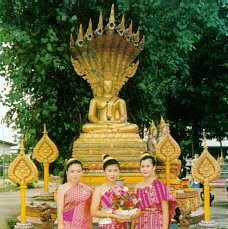SOCIAL OVERVIEW
![]() Currency
Currency
The KIP is the official currency of the Lao PDR and
bank notes are presently in denomination of 1000, 500, 100, 50, 20, 10, and 5
Kip.
There are money exchange facility at the airports, and several licensed bureau
in towns. Although It is best to always use cash to ensure the best bargains, a
few businesses and restaurants do accept travelers' checkes. Traveler's checkes
in other currency are best changed in Vientiane and the major provinces. In
general, US dollar traveler's checkes can be cashed at most banks in Lao PDR
nationwide. Major international credit cards, such as VISA, MasterCard, and
American Express are now being accepted in foreign banks, restaurants, hotels
and businesses shops.
![]() Culture
Culture
 |
Lao PDR used to be called Lane Xang, "The Land of A Million
Elephants". It was the name given to the country by King Fa Ngum whuen he
reunified the country in 1353 A.D.
Lao folk music features the khan, or Lao panpipe, a wind instrument that
is devised of a double row of bamboo like reeds fitted into a hardwood sound
box. The khean is often accompanied by a bowed string instrument or saw.
The National Dance is a folks dance called the Lamvong, or Circle Dance,
in which couples dance circles around one another until there are three circles
in all: a circle prescribed by an individual, a circle danced by a couple, and
one by the whole crowd.
 |
The cultural history of Lao PDR has been shaped by a blend of
three religions. The early Lao were animists, believers in spirits, and many of
these traditions still prevail; then Brahmanism spread eastward from the Indian
subcontinent, and finally Buddhism, the most obvious influence on Lao culture
today, made its unique influence on Lao PDR.
Many Lao males choose to be ordained as monks temporarily, normally spending
anywhere from a few days to three months at a wat or temple.
Lao art and architecture is often unique and expressive. Most tourists will
visit a wat or temple during their visit to Lao PDR, and see the
traditional turned-up roofs of the wat. Wat is the compound where monks reside.
Sculptures usually depicting the image of Buddha are distinctively Lao: the "calling
for rain" posture, which depicts the Buddha standing with his hand held
rigidly at the side, fingers pointing to the ground. The flat, elongated
earlobes, arched eyebrows and cauline nose are typically Lao. Another unique
feature is that the bottom of the image's robe turns up on both sides in a
perfectly symmetrical fashion.
![]() Customs, Gestures and Common
Courtesies
Customs, Gestures and Common
Courtesies
 |
The generally accepted form of greeting among Lao people is
the Nop, placing one's palms together in a position of praying, at chest level,
but not touching the body. The higher the hand, the greater the sign of respect,
although they should never be held above the level of the nose. This is
accompanied by a slight bow to show respect to persons of higher status or age.
The Nop is not only an expression of greeting, but also of thanks, of regret or
saying goodbye. However, it is appropriate to shake hands with westerners.
As in many Asian cultures, the head is considered the most sacred part of the
body, and the soles of the feet are the lowliest. One should not touch a
person's head nor use one's foot to point at a person or any object. Men and
women rarely show affection in public. It is forbiden for a women to touch a
Buddhist monk.
It is customary to remove one's shoes or sandals when entering a Buddhist temple
or private home. In Lao PDR, homes are raised off the ground, shoes or sandals
are left at the stairs. In a traditional home, one sits on low seats or cushions
on the floor. Men may sits with legs crossed or folded to one side. Women sits
with legs gracefully folded to the side. Guest me be served tea or fruit, which
should not be refused. On should at least take a taste.